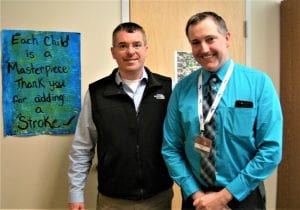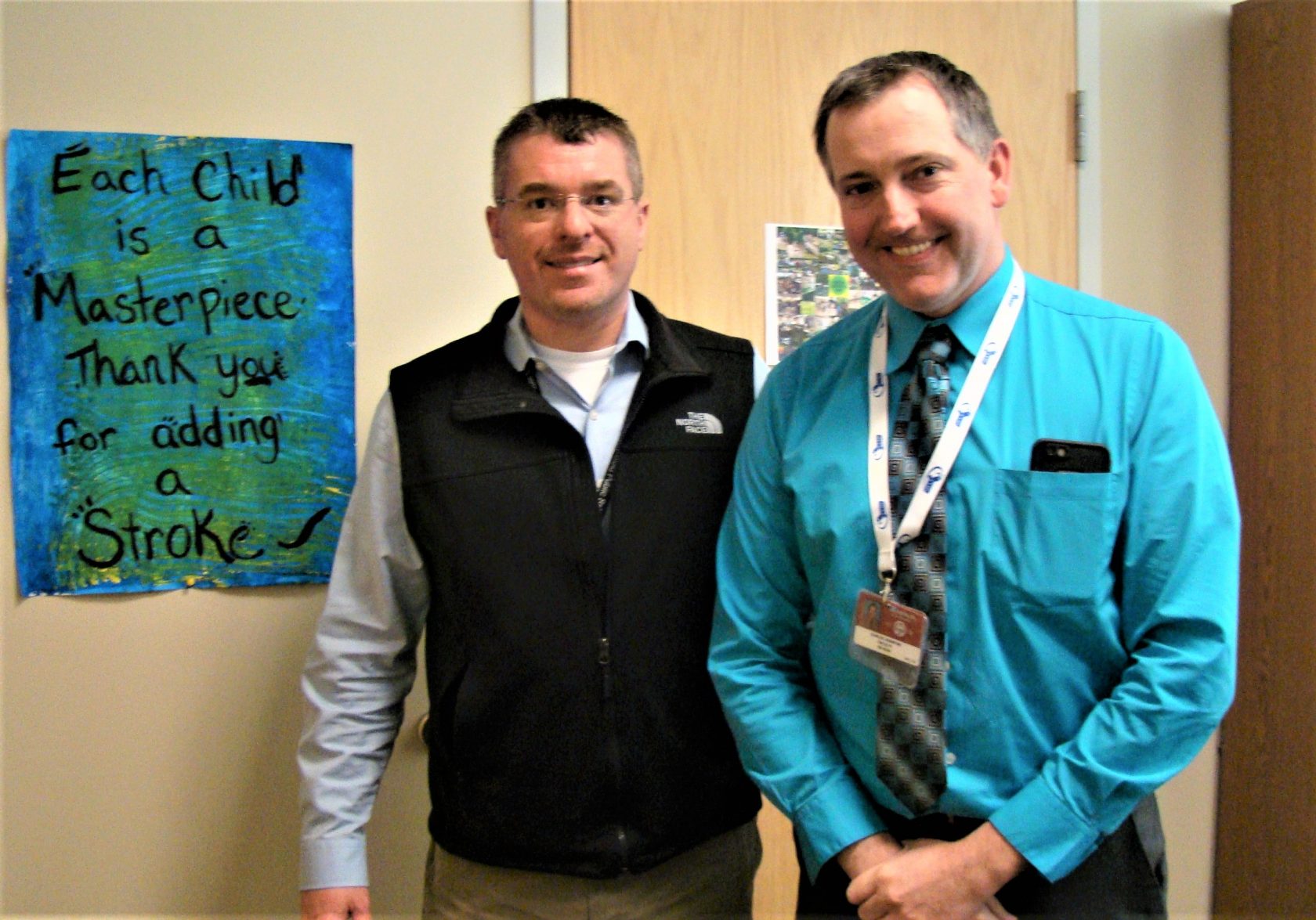
Superintendent Stefan Czaporowski and WHS Principal Charles Jendrysik. (Photo by Amy Porter)
WESTFIELD – Superintendent Stefan Czaporowski and Principal Charles Jendrysik have announced that Westfield High School has been fully accredited by the New England Association of Schools and Colleges (NEASC), receiving 32 commendations.
WHS also reported its lowest dropout rate in 25 years, at 1.1%. Czaporowski credited the work of Jendrysik and his assistant principals, including Julie Shortwell who oversees the Pathways program, for the lowered dropout rate, which at 1.1% is well below the state’s 1.9%.
“One of the things we do with Pathways is to get them back,” Czaporowski said about the alternative high school program. Last year, seven students came back who had previously dropped out.
The lowered dropout rate is the lowest for WHS in 25 years, ever since the state Department of Elementary and Secondary Education (DESE) has been keeping score. The WHS rate of 1.1% last year was down from 1.9% in 2017, and 2.7% in 2016; whereas the state average of 1.9% in 2018 had increased from 1.8% in 2017.
Among the commendations for WHS from NEASC was early college programming, increased internship opportunities for students, the addition of department content supervisors; supportive, caring and dedicated professionals at the school, and increased stakeholder involvement in decision making.
“For me, as a superintendent, I’m very pleased with the progress Westfield High School has made in the last three years,” Czaporowski said. He added that areas of concerns noted by NEASC in the report are already being addressed.
At a recent presentation to the School Committee, Susan Dargie, director of curriculum and instruction, talked about some of the changes that are being made in the curriculum, one of the areas of concern noted by NEASC for not having a consistent, written format.
Dargie said she worked with Chris Roger, administrator of student interventions and Denise Ruszala, director of assessment and accountability. “Our role is to provide support,” Dargie said.
Dargie also pointed to the work of Pre-k-12 technology coach Eric Masciadrelli, the grade 6 instructional coaches, and the grade 7-12 content supervisors; Mary Keane, ELA, Kate Perez, Math, Lauren Figy, Science, Technology and Engineering, and Jay Taylor, Social Studies, who are updating and mapping the curriculum. They also held a curriculum summit to get feedback from stakeholders.
The supervisors, who also addressed the School Committee, also pointed to some highlights. Perez has been invited to serve on DESE’s assessment development committee for grade 8 MCAS. She said the supervisors are also teaching professional development classes on early release days, and helping with content specific knowledge.
Keane talked about working one on one with teachers on content specific or requested skills. She said the supervisors do classroom observation and walk-throughs, and give explicit high level feedback.
Taylor said he is working on developing a criminal justice program for WHS in conjunction with Holyoke Community College, Springfield Technical Community College, Westfield State, and the Police Department Cadet program as a pathway, not only for students interest in a career in criminal justic, but in civics.
Figy talked about “Project Leads the Way,” a grade 8 engineering and computer science program that will lead into an Engineering pathway in WHS, thanks to a $97,500 grant WPS recently received for this and other programs. She also spoke about the 19th annual Science Fair, which had 241 projects from both high schools and over 100 community judges. “It was awesome,” Figy said.
Another area of concern in the NEASC report was the facilities, particularly the science labs, in WHS. Czaprowski said he and Jendrysik have working with the maintenance department to resolve concerns in the existing labs. He said they have fixed the drains, electrical outlets, and gas line repairs for the Bunsen burners. He added that they have also put in for replacement of science labs to Massachusetts School Building Authority. “It’s important to note we’re able to get the labs we have fully functioning,” Czaporowski said.
Czaporowski said that NEASC also commended the work that the schools are doing with the Westfield Education 2 Business Alliance, increasing the involvement of area businesses in the schools, along with internship and other opportunities for the students.
“I feel like the school climate has improved. It is important that the administration and faculty put time into building relationships, which helped the dropout rate,” Jendrysik said.


